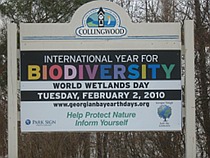Archive for March, 2009
Film Festival in Schools to be expanded 2010 to 2012
1600 students attended our November 18/19 2008 Nature Festival. Thank you to Ontario Trillium Foundation.
Visit to the Wye Marsh on May 25, 2009
Visit to the Wye Marsh on May 25, 2009 will bring 260 students for a full day of great conservation fun including rides in large canoes, walks through the marshlands, seeing birds of prey, and conservation awareness talks about climate change issues for wetlands. (Ontario Trillium Foundation has approved this project.)
Our third International Day of Climate Action
Our third International Day of Climate Action to be held during Copenhagen climate Change summit, December, 2009.
GTEDC’s partnership with Grey Sauble Conservation Authority continues to grow.
Planting 1500 trees in Grey County on April 23, 2009 is our first project with them. As well, Anne Lennox of Grey Sauble and GTEDC have surveyed an area of Flesherton Hills 101 acres Conservation area, and we expect to work with them and MacPhail Elementary School (meeting held on March 24, 2009) in a long-term educational project on biodiversity plots. Local students will be part of this project 4which looks at habitat and climate change.
nts.
Earth Week activities Celebrate Nature
April 22, 2009 brings GTEDC to two local public schools to celebrate our planet. Activities include use of quality microscope, planting seeds, visit from turtles, snakes and chicken, Toronto musician making recycled instruments with children (April 18th only at library), bee-keeping: why bees are important. Equipment shown and honey taste, flowerpots made from newspaper, and designing a garden.
GTEDC works for sustainable ultra-green development in Ontario
This five to seven year endeavour will bring critically needed changes to Ontario Provincial Policy Statement and the Niagara Escarpment Plan. ETEDC is spear-heading the capping of Greenhouse Gas emissions in development projects, both public and private.
The Precautionary Principle: Why won’t North Americans apply it to Climate Change?
James Hansen is arguably the most famous and brave climate scientist living today. He was asked to give evidence on behalf of a group of protesters who had broken into a coal-fired power plant in Britain and caused $70,000 worth of damage; the six activists did not deny what they did. “The not-guilty verdict, delivered after two days and greeted with cheers in the courtroom, raises the stakes for the most pressing issue on Britain’s green agenda and could encourage further direct action. The defense of “lawful excuse” under the Criminal Damage Act 1971 allows damage to be caused to property to prevent even greater damage. ” (The Independent, September 11)
Constitutions, Conservation, Culture, Coffee and Creativity: A Chant for Change
Many people around the world have been amazed to see Ecuador’s new constitution enshrine the “Rights of Nature” in a dazzling document that was supported by two-thirds of voters and President Rafael Correa’s government. The Precautionary Principle is celebrated in the new constitution. The background of this stunning achievement goes back to the abysmal ecological disasters that the Ecuadorian indigenous people sustained at the hands of Texaco-Chevron with the dumping of toxic waste from 1970 through 1992. After pocketing 30 billion dollars the company left behind what many have termed a Chernobyl–like catastrophe. A class-action lawsuit against Chevron by 30,000 Ecuadorians has been launched. Since then, Ecuador has been striving to corral the oil and gas companies into complying with the conservation needs of a nation where one third live in poverty and derive their livelihood from intact ecological systems. Chevron has tried to push Ecuador out of the Andean Free Trade Agreement as a result. Senator Obama has criticized this threat, saying “…we do believe the 30,000 indigenous residents of Ecuador deserve their day in court.” Out of this tragedy has emerged a powerful movement created by the Indigenous populations.
Albert Schweitzer and Rachel Carson: Two Courageous and inspiring People
Three years after receiving the Nobel Peace Prize in 1954, Albert Schweitzer addressed the world in his famous Declaration of Conscience. In a bid to stop the atmospheric testing of atomic and hydrogen bombs he sought to galvanize public opinion in order to influence Soviet, American and British governments. Dr. Schweitzer’s radio speech was part of a successful grassroots effort to bring to the forefront the short and long-term dangers that radiation poses to the future of life on Earth. He spoke of our descendents living with radioactive fallout. Land, air and water were all being affected by atomic testing. “It must not happen that we do not pull ourselves together before it is too late.” he said.
To this day most glaciers can be found to have a radioactive layer from the testing of the 50’s and 60’s. Scientists, by drilling ice cores, now use this information to see how much ice has accumulated since the 60’s to gage the glaciers’ potential meltwater for the future sustainability of rivers. Climate change is already taking its toll on these same glaciers to provide enough water for Asia’s populations.
Escarpment Biosphere Conservancy is Main Mover in Land Stewardship in our Area
Countries around the world search for solutions to stop the destruction of their forests and ecosystems habitats in order to save biodiversity, endangered species, and turn away from run-away greenhouse gas emissions. In the West we have been asked to put together action plans that balance our demand for wood, biofuel, and resource taking with the protection of huge areas of pristine forest. These plans have been the subject of intense scrutiny by the United Nations, International Union for the Conservation of Nature to the World Bank. Deforestation and farm community fragmentation are some of the main causes for an increase in greenhouse gas emissions; we must do more to see real financial value in undisturbed forests and other natural areas that encompass so much of the Earth’s biodiversity!

